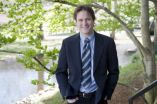(Press-News.org) Two Northeastern University researchers and their international colleagues have created an advanced model aimed at exploring the role of neutral evolution in the biogeographic distribution of ocean microbes.
Their findings were published Thursday in the journal Science. The paper—titled "Biogeographic patterns in ocean microbes emerge in a neutral agent-based model"—was co-authored by Ferdi Hellweger, a microbial ecology expert and an associate professor of civil and environmental engineering; his doctoral student Neil Fredrick, PhD'15; and oceanographer Erik van Sebille of Australia's University of New South Wales.
Their results flew in the face of the long held notion that microbes are infinitely mobile—that the same cells could be found anywhere in the world's oceans, unhindered by geographic boundaries. On the contrary, the researchers found that microbes evolve faster than the ocean circulation can disperse them, leading to substantial—and dynamic— biogeographic patterns in their surface ocean population.
"Microbes differ between provinces because of neutral evolution and dispersal limitation," said Hellweger, whose ongoing research on this topic is supported by grants from the National Science Foundation and the National Oceanic and Atmospheric Administration. "Because provinces are not well-mixed, the differences can continue to grow."
What's more, the findings shed light on how ocean microbes may respond to global climate change. "You may not see microbes adapt to climate change as rapidly if ocean microbes were completely mixed and they were everywhere," Hellweger posited. "Certain species of microbes may not thrive under new temperatures in certain provinces."
Over the past several decades, ecologists have come to understand that both natural selection and neutral evolution—that variation within and between species is caused by genetic drift and random mutations—play a role in the biogeographic patterns of ocean microbes. In this study, Hellweger et al. quantified the role of neutral processes by simulating division, mutation, and death of some 100,000 individual marine bacteria cells with full genomes in a global surface ocean circulation model.
INFORMATION:
They ran the model for up to 100,000 years and then analyzed the output using advanced DNA alignment algorithms.
Up next: Hellweger, Fredrick, and van Sebille will use a similar modeling approach to explore deep ocean microbes in addition to environmental selection.
Microbes evolve faster than ocean can disperse them
Research findings shed light on how ocean microbes may respond to global climate change
2014-09-12
ELSE PRESS RELEASES FROM THIS DATE:
Inflammation may be key to diabetes/heart disease link
2014-09-11
Inflammation may be the reason high blood sugar levels damage blood vessels, raising the possibility that anti-inflammatory medications might someday be used to lower the risk of blood vessel disease in people with diabetes, according to a study presented at the American Heart Association's High Blood Pressure Research Scientific Sessions 2014.
"These findings may explain why good blood sugar control is not sufficient to avoid the development of diabetes-induced cardiovascular diseases," said Carlos F. Sánchez-Ferrer, M.D., Ph.D., study author and professor of pharmacology ...
Cutting the cord on soft robots
2014-09-11
When it comes to the development of soft robots, researchers have finally managed to cut the cord.
Engineers at Harvard's School for Engineering and Applied Sciences and the Wyss Institute for Biologically Inspired Engineering have developed the world's first untethered soft robot – a quadruped which can literally stand up and walk away from its designers.
Working in the lab of Charles River Professor of Engineering and Applied Sciences Robert Wood, a team of researchers that included Michael Tolley, Robert Shepherd, Bobak Mosadegh, Kevin Galloway, Michael Wehner ...
NASA research helps unravel mysteries of the Venusian atmosphere
2014-09-11
VIDEO:
New research shows giant holes in Venus' atmosphere -- which serve as extra clues for understanding this planet so different from our own.
Click here for more information.
Underscoring the vast differences between Earth and its neighbor Venus, new research shows a glimpse of giant holes in the electrically charged layer of the Venusian atmosphere, called the ionosphere. The observations point to a more complicated magnetic environment than previously thought – which ...
Tipping the balance of behavior
2014-09-11
Humans with autism often show a reduced frequency of social interactions and an increased tendency to engage in repetitive solitary behaviors. Autism has also been linked to dysfunction of the amygdala, a brain structure involved in processing emotions. Now Caltech researchers have discovered antagonistic neuron populations in the mouse amygdala that control whether the animal engages in social behaviors or asocial repetitive self-grooming. This discovery may have implications for understanding neural circuit dysfunctions that underlie autism in humans.
This discovery, ...
Original northern border of Illinois was south of Chicago and Lake Michigan
2014-09-11
URBANA, Ill. – Chicago residents today might have had a Wisconsin zip code if the originally proposed northern boundary of Illinois had been approved. It was a straight line from the southernmost tip of Lake Michigan to just south of the Rock and Mississippi River confluence. University of Illinois soil scientist Ken Olson said that had the proposed northern border not been changed, the state of Illinois would have a much smaller population and footprint with the northern 51 miles of the Illinois Territory ceded to Wisconsin when it became a state in 1848.
Olson says ...
Diabetes researchers find faster way to create insulin-producing cells
2014-09-11
University of British Columbia, in collaboration with BetaLogics Venture, a division of Janssen Research & Development, LLC, has published a study highlighting a protocol to convert stem cells into insulin-producing cells. The new procedure could be an important step in the fight against Type 1 diabetes.
The protocol can turn stem cells into reliable, insulin-producing cells in about six weeks, far quicker than the four months it took using previous methods.
"We are a step closer to having an unlimited supply of insulin-producing cells to treat patents with Type ...
One-minute point-of-care anemia test shows promise in new study
2014-09-11
A simple point-of-care testing device for anemia could provide more rapid diagnosis of the common blood disorder and allow inexpensive at-home self-monitoring of persons with chronic forms of the disease.
The disposable self-testing device analyzes a single droplet of blood using a chemical reagent that produces visible color changes corresponding to different levels of anemia. The basic test produces results in about 60 seconds and requires no electrical power. A companion smartphone application can automatically correlate the visual results to specific blood hemoglobin ...
Meditation may mitigate migraine misery
2014-09-11
WINSTON-SALEM, N.C. – Sept. 11, 2014 – Meditation might be a path to migraine relief, according to a new study by researchers at Wake Forest Baptist Medical Center.
"Stress is a well-known trigger for headaches and research supports the general benefits of mind/body interventions for migraines, but there hasn't been much research to evaluate specific standardized meditation interventions," said Rebecca Erwin Wells, M.D., assistant professor of neurology at Wake Forest Baptist and lead author of the study published in the online edition of the journal Headache.
The study ...
Yogic breathing shows promise in reducing symptoms of post-traumatic stress disorder
2014-09-11
MADISON, Wis. — One of the greatest casualties of war is its lasting effect on the minds of soldiers. This presents a daunting public health problem: More than 20 percent of veterans returning from the wars in Iraq and Afghanistan have post-traumatic stress disorder, according to a 2012 report by RAND Corp.
A new study from the Center for Investigating Healthy Minds at the Waisman Center of the University of Wisconsin-Madison offers hope for those suffering from the disorder. Researchers there have shown that a breathing-based meditation practice called Sudarshan Kriya ...
Volunteer 'eyes on the skies' track peregrine falcon recovery in California
2014-09-11
In recovery from the deadly legacy of DDT, American peregrine falcons (Falco peregrines anatum) faced new uncertainty in 1992, when biologists proposed to stop rearing young birds in captivity and placing them in wild nests. Tim Wootton and Doug Bell published models that year in ESA's journal Ecological Applications, projecting population trends for the falcon in California, with and without direct human intervention in the falcons' reproductive lives. They concluded that the birds would continue to recover without captive rearing, though the population growth rate might ...
LAST 30 PRESS RELEASES:
SIMJ announces global collaborative book project in commemoration of its 75th anniversary
Air pollution exposure and birth weight
Obstructive sleep apnea risk and mental health conditions among older adults
How talking slows eye movements behind the wheel
The Ceramic Society of Japan’s Oxoate Ceramics Research Association launches new international book project
Heart-brain connection: international study reveals the role of the vagus nerve in keeping the heart young
Researchers identify Rb1 as a predictive biomarker for a new therapeutic strategy in some breast cancers
Survey reveals ethical gaps slowing AI adoption in pediatric surgery
Stimulant ADHD medications work differently than thought
AI overestimates how smart people are, according to HSE economists
HSE researchers create genome-wide map of quadruplexes
Scientists boost cell "powerhouses" to burn more calories
Automatic label checking: The missing step in making reliable medical AI
Low daily alcohol intake linked to 50% heightened mouth cancer risk in India
American Meteorological Society announces Rick Spinrad as 2026 President-Elect
Biomass-based carbon capture spotlighted in newly released global climate webinar recording
Illuminating invisible nano pollutants: advanced bioimaging tracks the full journey of emerging nanoscale contaminants in living systems
How does age affect recovery from spinal cord injury?
Novel AI tool offers prognosis for patients with head and neck cancer
Fathers’ microplastic exposure tied to their children’s metabolic problems
Research validates laboratory model for studying high-grade serous ovarian cancer
SIR 2026 delivers transformative breakthroughs in minimally invasive medicine to improve patient care
Stem Cell Reports most downloaded papers of 2025 highlight the breadth and impact of stem cell research
Oxford-led study estimates NHS spends around 3% of its primary and secondary care budget on the health impacts of heat and cold in England
A researcher’s long quest leads to a smart composite breakthrough
Urban wild bees act as “microbial sensors” of city health.
New study finds where you live affects recovery after a hip fracture
Forecasting the impact of fully automated vehicle adoption on US road traffic injuries
Alcohol-related hospitalizations from 2016 to 2022
Semaglutide and hospitalizations in patients with obesity and established cardiovascular disease
[Press-News.org] Microbes evolve faster than ocean can disperse themResearch findings shed light on how ocean microbes may respond to global climate change




